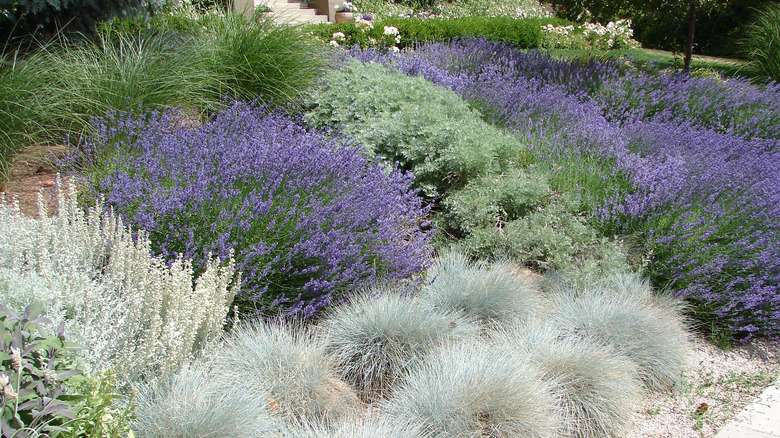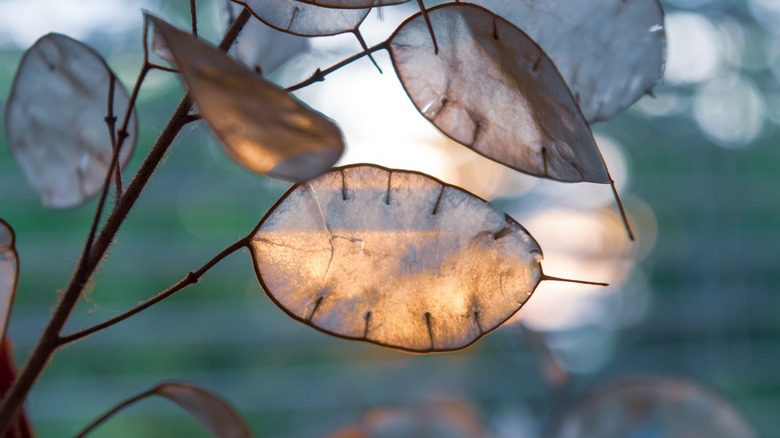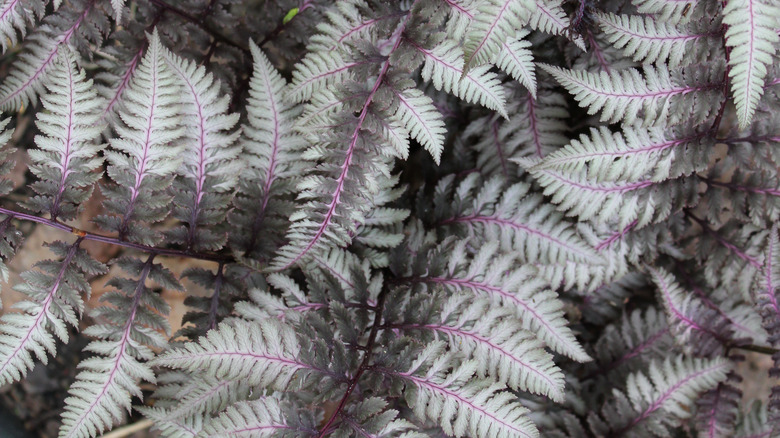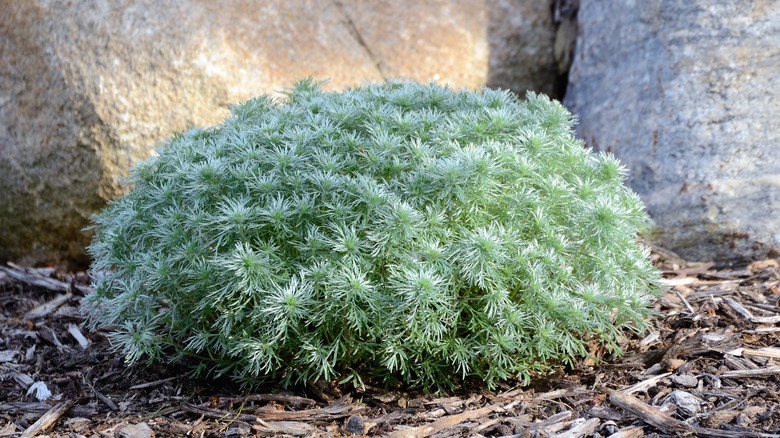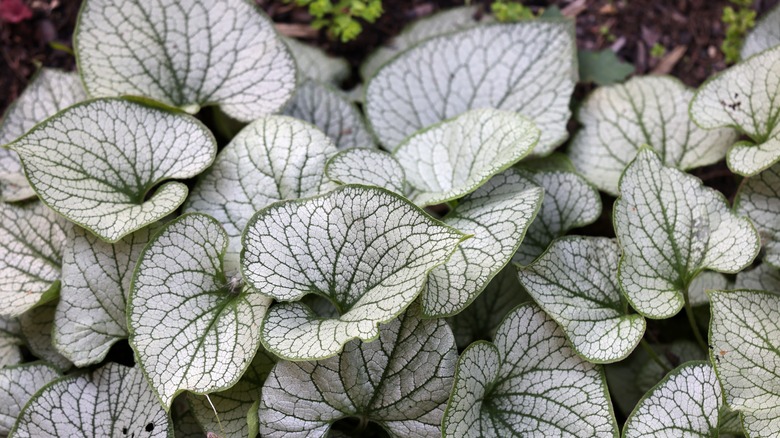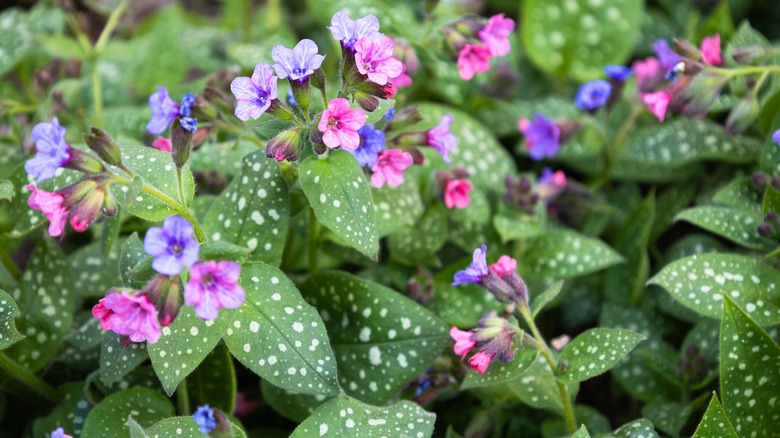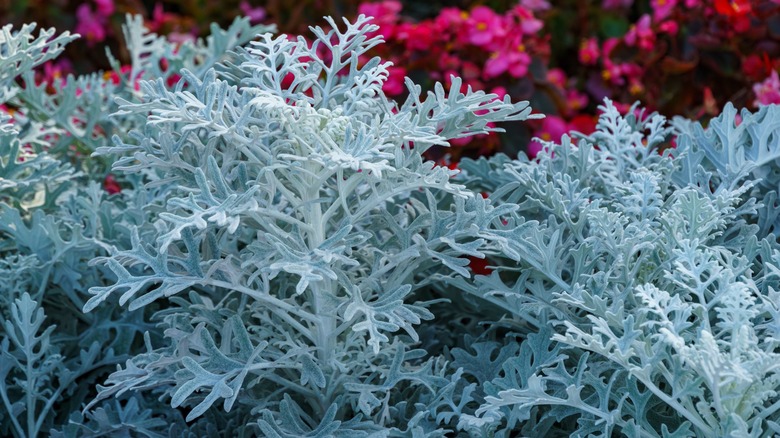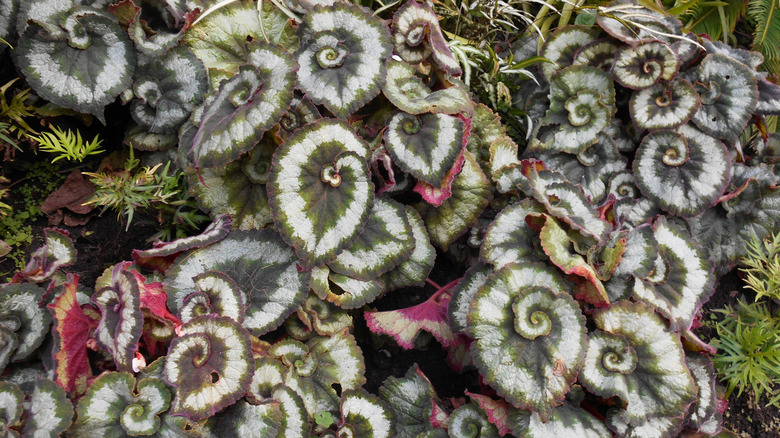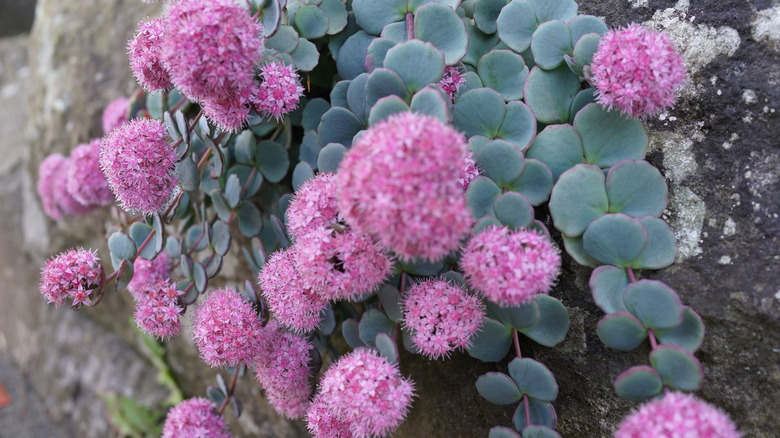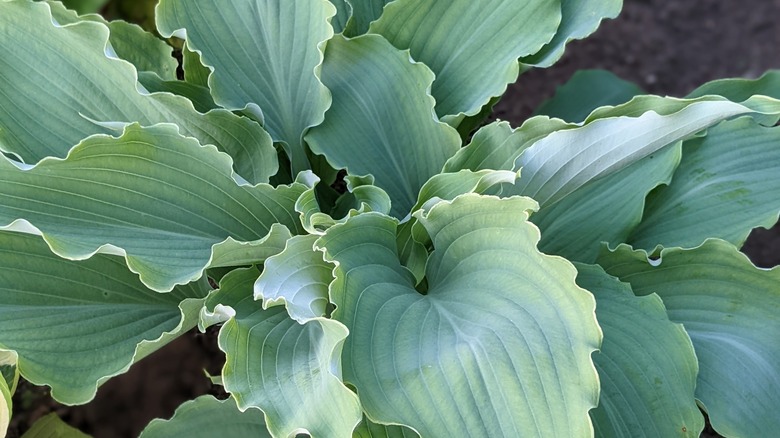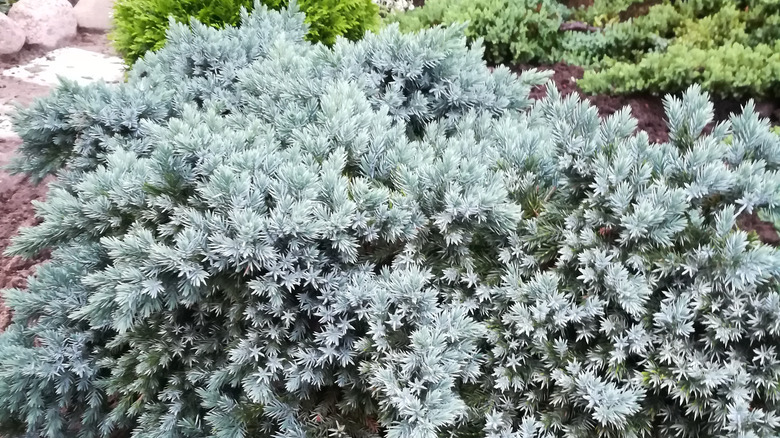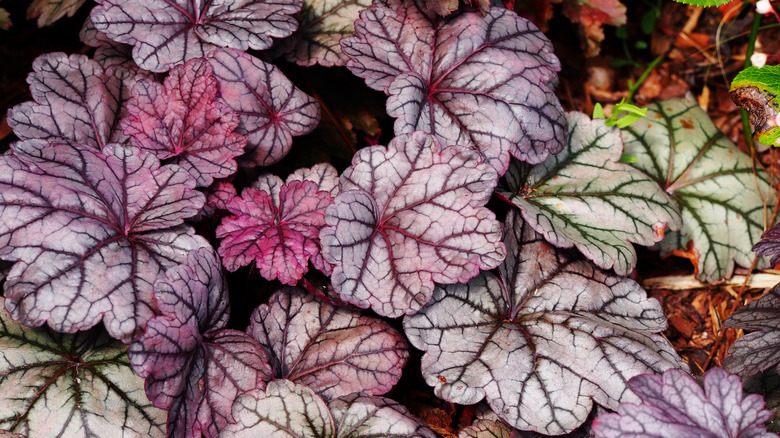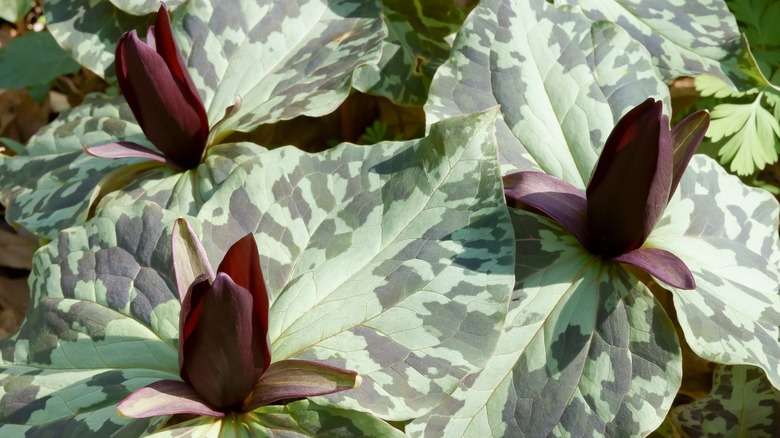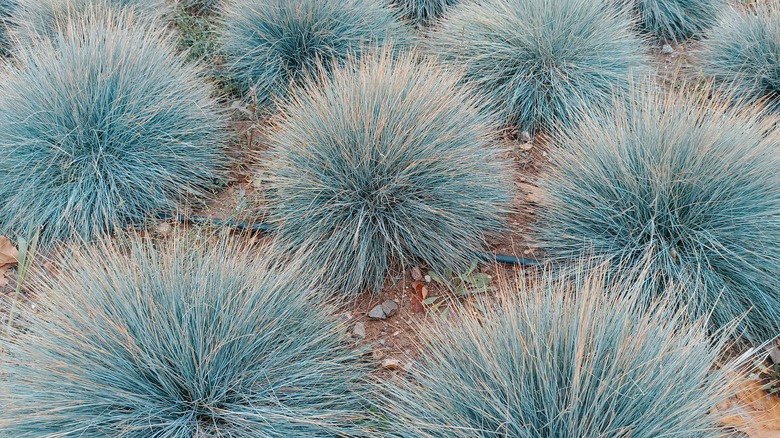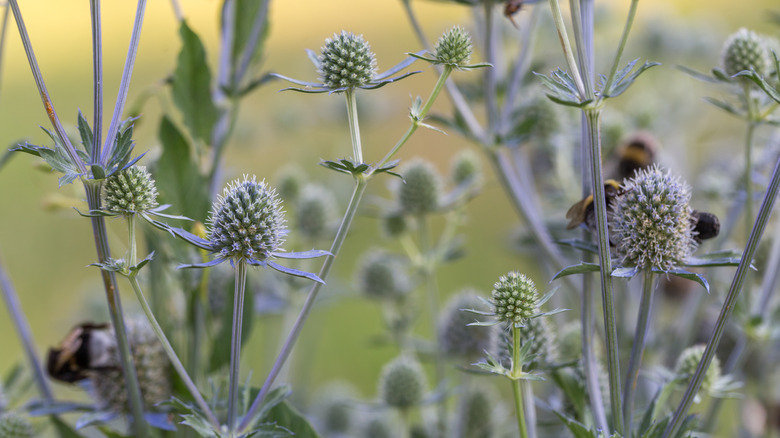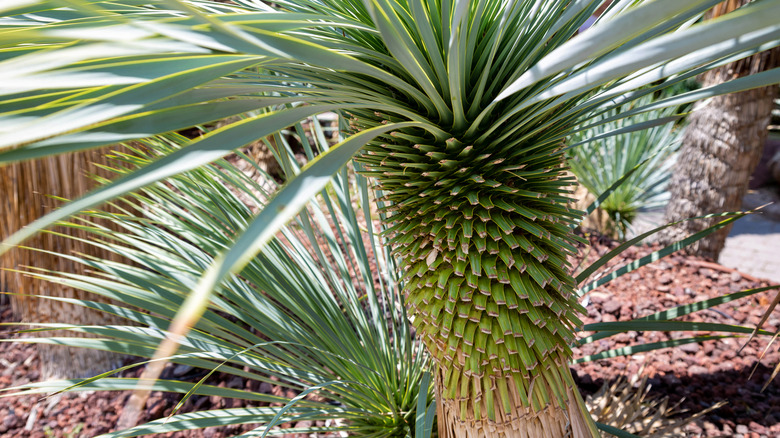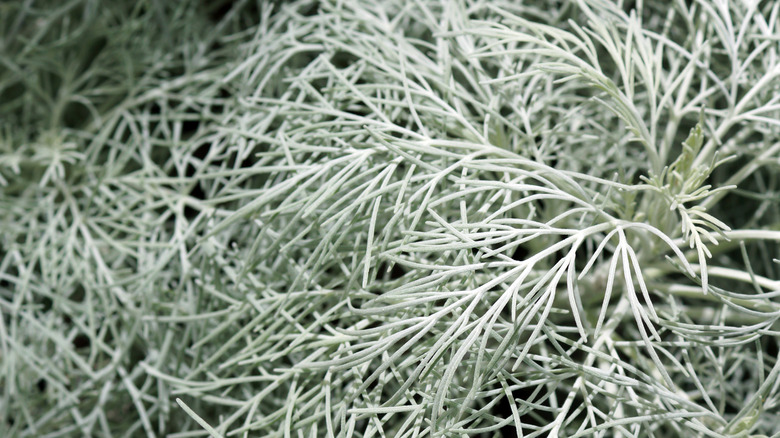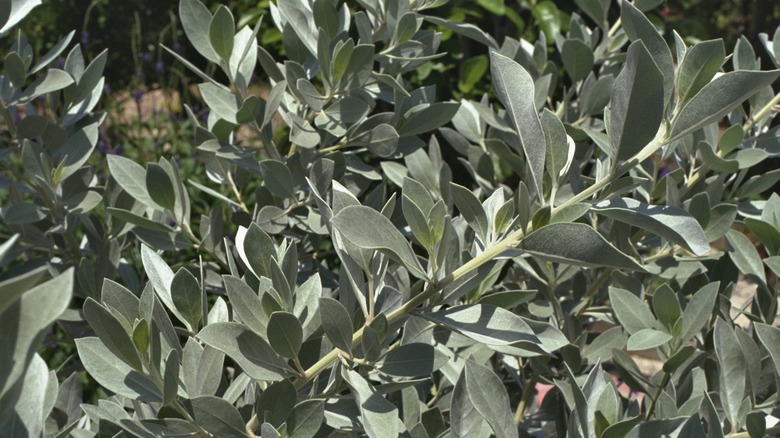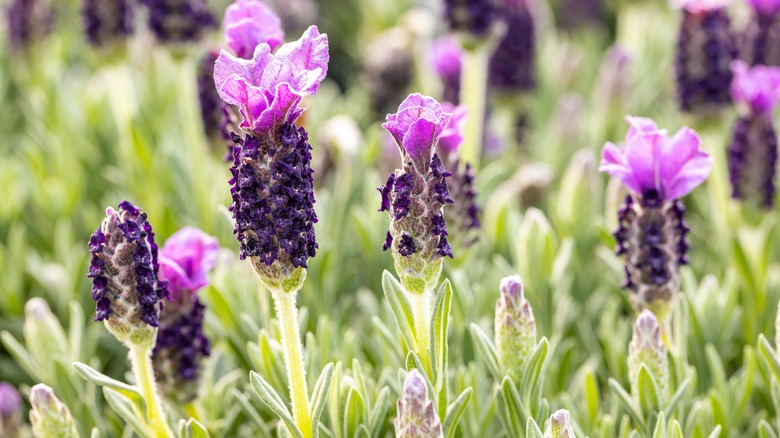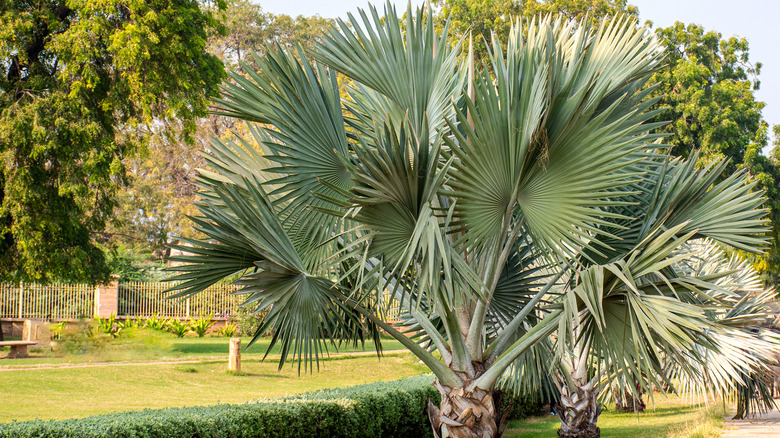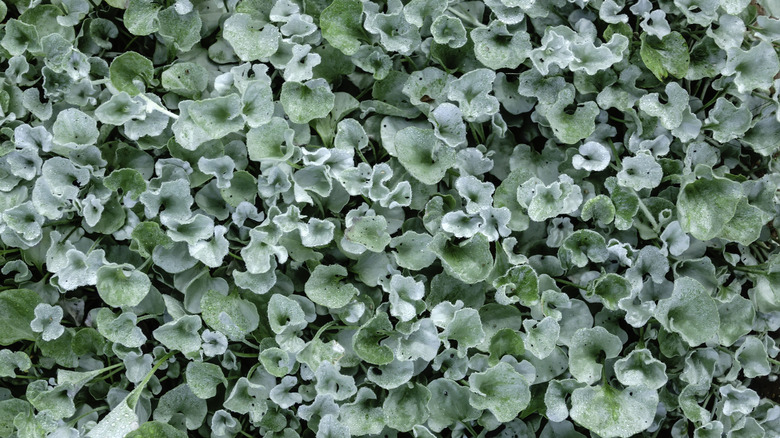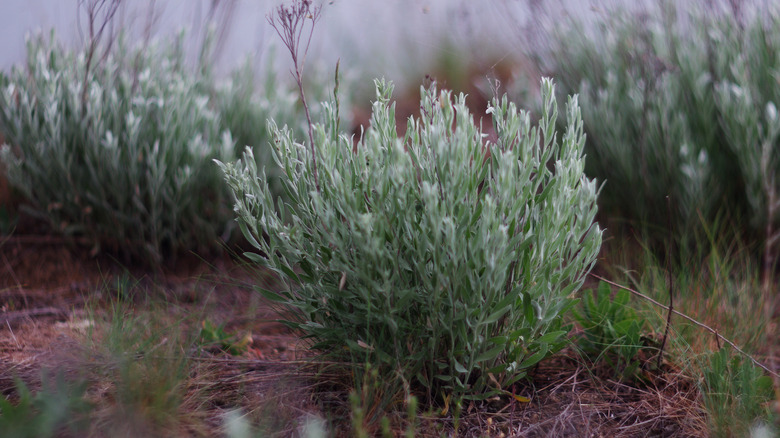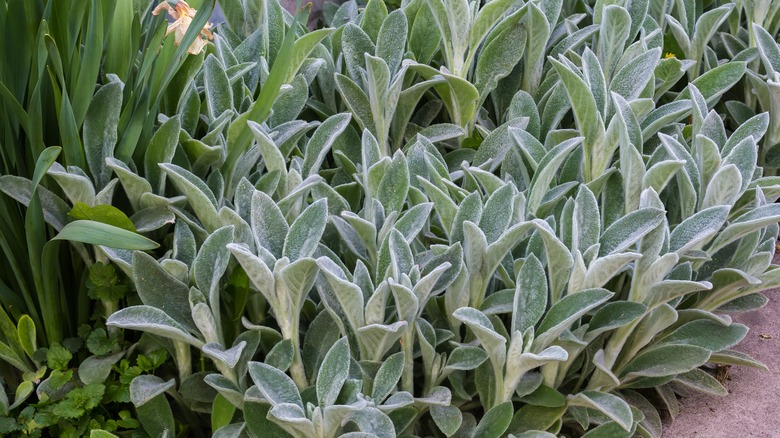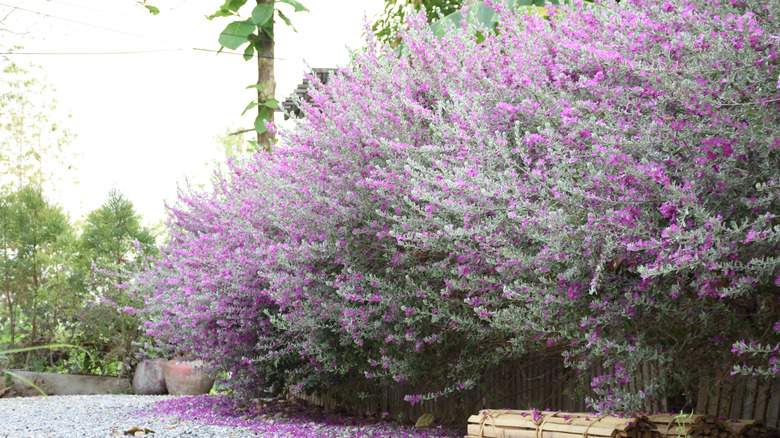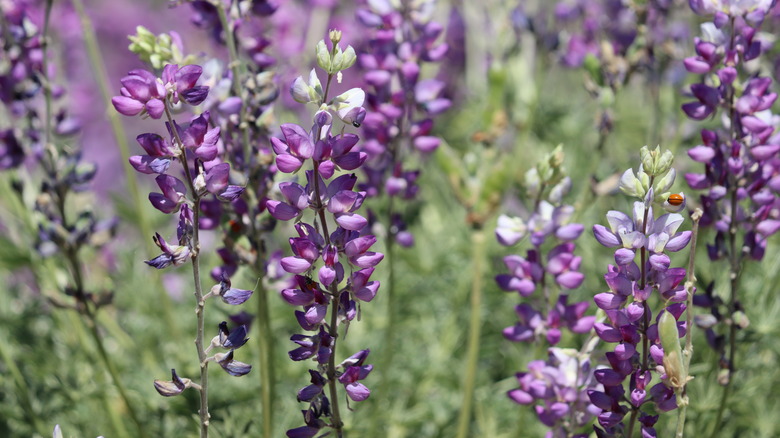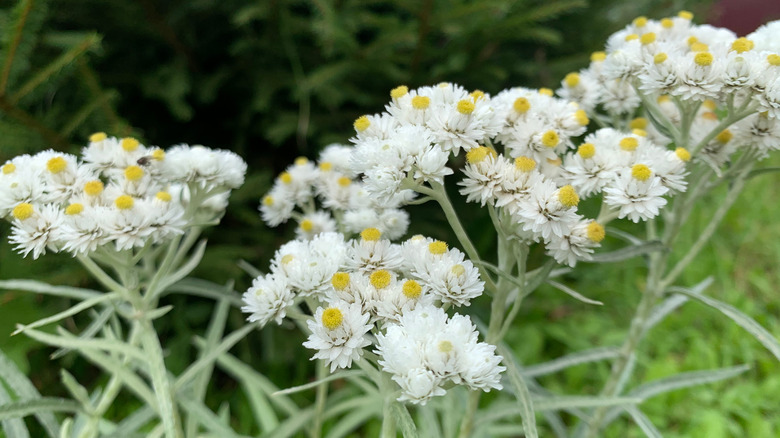25 Plants With Silver Foliage To Give Your Garden A Fantasy Vibe
News flash: silver-colored plants are stunning. Although, you probably already knew that. These ethereal plants have long been used as accents in residential gardens, but they also shine (sometimes quite literally) when allowed to flourish in silver-forward landscaping. Additionally, many plants in this color are both drought-tolerant and low maintenance, from succulents and palms to native shrubs. They often come in unusual shapes: spiny and angular like yucca, floppy like wormwood, or round like pom-pom-shaped clumping grasses. Some have a fuzzy texture, like lamb's ear, as leaves and stems lined with small hairs are often what give these plants their shimmery appearance. So whether you're looking to give your garden a few well-placed accents or create an all-silver, fantastical garden straight out of the pages of a book, we've got you covered.
This list of sometimes-lovely, sometimes-surprising plants will help you create a garden that's as unique as you are. Some may be familiar, while others look downright otherworldly. However, what they have in common is that all can thrive in a residential garden setting. In fact, many will even grow well alongside each other. When looking for companion plants, choose those that thrive in the same soil and light conditions. Check the labels on your seed packets and starter plants, too. Some seed companies and nurseries will give you helpful hints about which plants work well together. Good luck with creating your silver garden!
1. Otherworldly Lunaria
Ethereal Lunaria, appropriately referred to as the silver dollar plant, shimmers with translucent silvery seed pods. Before revealing its signature pods, it blooms with clusters of purple flowers that attract pollinators. Typically grown from seed, this flower should be planted in a sunny spot in fall or early spring. Keep in mind it will take two years to become established and flower. However, once it does, it will self-seed as long as some seed pods remain on the plant. You may not want to leave many seeds, though. After all, lunaria seed pods make a lovely element in cut flower arrangements.
2. Shade loving 'Regal Red' Japanese painted fern
Although it's called red, the regal red Japanese fern (Athyrium niponicum 'Regal Red') features fronds touched with silver. Like many ferns, it loves moisture, shade, and should be kept well watered. Suitable planting locations outdoors include USDA growing zones 4 through 8, but this perennial can also be grown indoors as a houseplant. When grown outdoors, it will spread gradually through rhizomes. It can also be divided and propagated. Plant them alongside other shade-loving plants, including coral bells, which also earned a spot on our list.
3. Round and small silver mound
Perfect for borders, silver mound (Artemisia schmidtiana) has delicate, frost-colored foliage resembling those of an evergreen pine. Although not a pine, this perennial is evergreen in warmer zones. The mounding plant spreads, forming a blanket of soft leaves. You can help it spread more quickly by dividing the plant every few years. Due to its hardy and drought-tolerant nature, silver mound is suitable for rock gardens. In fact, it even prefers poorer soil as long as it's well-draining. It pairs well with plants that thrive in the same soil type, like lavender, which is also on this list.
4. A brunnera by any name
Brunnera Sterling Silver (Brunnera macrophylla), a type of Siberian Bugloss, is a stunning shade-loving plant for a woodland garden. Grown primarily for its striking foliage, it also sends up delicate blue flowers in spring that attract pollinators. Brunnera is available in other varieties that would equally suit a silvery garden. These options include Emerald Mist and Looking Glass. Although Sterling Silver is more heat tolerant than others, there is only a moderate difference in the plants' care requirements. The primary distinction is visual and can be seen in the variation in the pattern and size of the leaves.
5. Speckled lungwort
Lungwort (Pulmonaria spp) gets its name from its leaves, which some have thought resemble a sickly lung in shape and speckled color. While the comparison may strike others as a bit unsettling, these plants make a whimsical addition to the garden. Available in more than a dozen varieties, what lungwort has in common across species is a touch of silver. However, how much silver is present on the foliage depends on the type. For extra spotting, consider the varieties Dark Vader and Majesty. Plant this perennial in part sun or shade, and keep it well-watered to encourage flowering.
6. Shapely dusty miller
Long favored by gardeners for its lacy leaves, dusty miller (Senecio cineraria) often serves as an accent to more vibrant colored flowers. However, the plant is more than just a sidekick. Many varieties of dusty miller give forth clusters of flowers. However it is the velvety leaves, varying by cultivar, that steal the show. Because dusty miller is evergreen and perennial it continues to add interest to the garden for years. It can be planted as a border; however, because it can reach up to two feet tall, it can also add height in the middle of the back of a bed.
7. Swirly Begonia rex escargot
A whimsical addition to the garden, Begonia rex escargot has spiral-shaped foliage in green and silver. The leaves' undersides are striking purple. Rex Begonia species prefers partial shade and moist soil. Like many plants that grow in moist soil, it is prone to fungal diseases. For that reason, keep the garden free of dead leaves to reduce the risk of infection. If you like Begonia, you may enjoy other varieties, such as 'Jurassic' or 'Black Beauty.' That said, steer clear of this plant if you have mischievous pets, as it is toxic to dogs and cats.
8. Trailing October Daphne
Many stonecrop varieties, including October Daphne (Hylotelephium sieboldii), have a frosty blue tint to their succulent leaves. One of the marvels of this succulent perennial is that its leaves change colors with the seasons. In fall, expect silvery tones to give way to warm pink, red, and orange. Suitable for poor but well-draining soils, stonecrop is a great ground cover or pick for rock gardens. With so many types of sedum available, all with similar care requirements, this plant can be paired with others in its family. Far from repetitive, the different shapes and colors of sedum create a diverse display.
9. Shade-loving Hosta 'Waterslide'
There are countless types of hosta, all of which make great additions to a shade garden. Hosta 'Waterslide' has two things not all of its counterparts do: silvery leaves and ruffled foliage. Waterslide is related to Hosta Neptune, another ruffled variety, but has a more grayish appearance. It gives forth flowers in late summer. Plant this in a lightly shaded spot in your garden and keep the soil moist. Hosta clumps will continue to grow if left alone, or you can divide them in spring to fill in other parts of your yard.
10. Spiny 'Blue Star' Juniper
Dense branches of silvery blue needles make blue star Juniper (Juniperus squamata) a low-maintenance shrub that's popular for borders and rock gardens. Looking at the end of a branch straight-on, you'll understand why the plant is called 'Blue Star.' The shape clearly resembles that of a star. This slow-growing evergreen can reach a height and width of 1 to 3 feet. Once established, it doesn't need much in the way of watering. Some gardeners find pruning unnecessary, although dead or overgrown limbs can be removed in the spring.
11. Coral bells in many colors
Heuchera, or coral bells, is a beautifully low-maintenance plant. There are dozens of varieties, with foliage ranging from green to red, purple, and, yes, silver. Some varieties to seek out are Silver Scrolls, Stainless Steel, Silver Gumdrops, Northern Exposure, and Smoke and Mirrors. Some varieties have leaves that change color throughout the year. So, if a color-coordinated garden is important to you, read up on your coral bell plant to understand how foliage will play off your other plants. Although they're grown mainly for their showy leaves, their flower spikes attract pollinators.
12. Unusual 'Baton Rouge' foetid toadshade
Native to the floodplains of the Mississippi River, foetid toadshade (Trillium foetidissimum) looks almost like a water lily with its saucer-shaped leaves topped with cup-shaped flowers. As its name suggests, it has an odor that may be less than pleasant. However, this wildflower makes up for it with the unique silhouette it strikes in the garden. Plus, its leaves are edible and can be cooked and prepared like collard, mustard, or other greens. Word to the wise: do this only if your garden is free from pesticides.
13. Clusters of blue fescue
From afar, blue fescue (Festuca ovina glauca) looks like steel-blue puffs floating on a garden bed. This small and compact grass grows in mounds that reach about 1 foot tall and wide. Plant these in groups rather than solo for a bigger impact. Blue fescue does not spread, so plant them as densely, about 8 inches apart. This colorful ornamental grass is suited for full sun, where its blue color becomes most pronounced. Consider adding it to a rock garden with well-draining soil or a bed where it can act as ground cover.
14. Salt-resistant sea holly
For a fantastical (and spiky) addition to the garden, sea holly (Eryngium × zabelii 'Big Blue') fits the bill. Covered in frosty-colored spiny leaves and producing icy blue thistle-like flowers, this plant would look singular in many garden beds. Sea holly is prone to root rot, so plant it in well-draining, preferably sandy, soils. On the upside, the plant is drought-tolerant. As the name suggests, it can tolerate seaside placements, as it is salt-tolerant. More points in its favor: rabbits and deer avoid its sharp leaves, while bees and butterflies flock to its unusual flowers in summer.
15. Gentle Yucca rostrata
Yucca rostrada, also known as beaked yucca or big bend yucca, is a tree-like plant that can reach about 5 feet tall. From among the succulent needles, white flower spikes emerge each spring, attracting hummingbirds and butterflies. While you can plant Yucca rostrada directly in the ground or in a rock garden, for instance, it will also tolerate being grown in containers. Those familiar with lower-growing yucca may be surprised by the relative softness of this plant's leaves. This makes it easier to move and garden around the plant without incurring some accidental scratches.
16. Soft Maui wormwood
Maui wormwood (Artemisia mauiensis) is a small shrub with delicate, floppy, and frosty-colored foliage. It looks almost like something from a fantastical children's picture book, perhaps more so when it's trained to grow as a specimen tree. Like many plants on this list, it loves full sun and well-draining soil. Native to Hawaii, as its name suggests, it is accustomed to growing in rocky terrain, so consider it for a rock garden, drought-friendly xeriscape garden, or other rugged placements. Cold-weather gardeners beware: this lovely shrub is hardy only in warmer climes, specifically zones 9 to 11.
17. Sturdy silver buttonwood
Native to Florida and the Caribbean, silver buttonwood (Conocarpus erectus var. sericeus) is a salt-tolerant shrub suitable for coastal gardens. Another reason to plant it in these and similar regions, is that it's resilient against tropical storms and hurricanes. The leaves practically glitter in the sun, thanks to the fine silvery hairs that line the foliage. If you're looking to lure more wildlife to your yard, this plant is a great choice for its fruits, which attract birds like mockingbirds, cardinals, and catbirds. These species may even nest in its branches, a happy sight for gardeners with a penchant for bird watching.
18. Fragrant French lavender
Although it's often called low-maintenance, make the mistake of overwatering French lavender (Lavandula stoechas) or planting in the wrong soil type, and it will perish. Nevertheless, if you're after lovely flowers, you can hardly do better than this fragrant plant. French lavender has a less powerful aroma than its English cousin, but it's delightful nonetheless. It requires little watering and prefers poor soils. However, it doesn't like wet feet, so find a well-draining location. It will do well in container gardens if you amp up your watering routine. When properly cared for, this perennial will return each year.
19. Big Bismark palm
Bismark palm (Bismarckia nobilis) makes a dramatic accent tree in drought-prone and warmer zones. Native to Madagascar, it soars to up to 12 feet high. Its silver-green fan-like fronds make a big statement that makes the plant a fine choice for solo plantings or small groupings. Create an oasis of silver in your yard by pairing it with silver buttonwood and Texas sage, both of which are also on this list. Although they're fairly low maintenance, dead growth should be pruned, which is a gardening chore that will be familiar to those who have grown palm trees.
20. Creeping silver nickel vine
Silver nickel vine (Dichondra argentea 'Silver Falls') cascades in a shimmery curtain, over rock walls or hanging baskets. However, it's also one of the best groundcovers, spreading in garden beds through its rooting stems. Choose a location in full sun to part shade and ensure it has well-draining soil. Keep in mind that silver nickel vine is native to desert regions and should not be overwatered. So neglect it for a while after a rain. You can grow the plant as an annual in most zones, or even as a perennial in warmer climates.
21. Resilient silver sagebrush
Gardeners living in wetter climates will love silver sagebrush (Artemisia cana). In its native range, in the central United States, this plant can be found growing in floodplains and withstands heavy rains. The shrub can grow as high as 3 feet. It's a good addition to a sensory garden, given the plant's interesting and spicy aroma. Or, consider it for a xeriscape garden due to its hardiness. Natural stretches of silver sagebrush draw several species of native songbirds in the wild, so you might expect winged visitors to your yard, should you choose to plant it.
22. Fuzzy lamb's ear
A familiar site in residential and corporate plantings, lamb's ear (Stachys byzantina) is a classic for a reason. Its fuzzy foliage and silver-green color make it an attractive counterpoint to brightly colored flowers. In fact, lamb's ear has flowers of its own—purple clusters that grow on tall spikes. However, many gardeners clip these to keep the plant from getting leggy. Lamb's ear plants are perennial and even evergreen in warmer climates. Remember: lamb's ear can spread fast when conditions are right. So, stay on top of maintenance if you'd rather this plant remain more of an accent and less of a groundcover.
23. Towering Texas sage
Texas sage (Leucophyllum frutescens) proves the well-known adage: everything is bigger in Texas. These shrubs grow up to 6 feet wide and 6 feet tall. Due to their profusion of purple flowers, they make a big visual impact at that size. Its flowering schedule is unconventional, and is dependent on the weather. Also called the barometer bush, Texas sage flowers in high humidity conditions, as before and after a rainstorm. Flowering can occur sporadically throughout the spring and summer. Plant this shrub in full sun and away from the house or outbuildings so it can spread out.
24. Beautiful silver lupine
With gray-green foliage and spikes of purple flowers, silver lupine (Lupinus albifrons) is a charming pick for a silvery garden. It's a short-lived perennial, typically three to four years, but it can self-sow if conditions are right. Growing up to 5 feet, it adds both height and drama to the garden. It's a beloved food source for butterflies, bees, and birds but is toxic if ingested in large amounts by humans or pets. It's recommended to wear gloves when handling silver lupine and to follow up by washing your hands. Still, provided that you take simple precautions, it's a versatile garden plant.
25. Perennial pearly everlasting
Pearly everlasting (Anaphalis margaritacea), a relative of sunflowers, is a native wildflower that thrives in poor soils, rocky soils, and full sun. This drought-tolerant perennial will spread through stolons quickly when watered and fertilized. So, to keep it confined to a specific area, you can pull back on the watering routine and withhold fertilizers. Clusters of flowers bloom in July and August and bring pollinators to the yard. These can be cut and used in bouquets or dried flower arrangements. The stiff bracts (often mistaken for outer petals) hold their shape well after drying.
